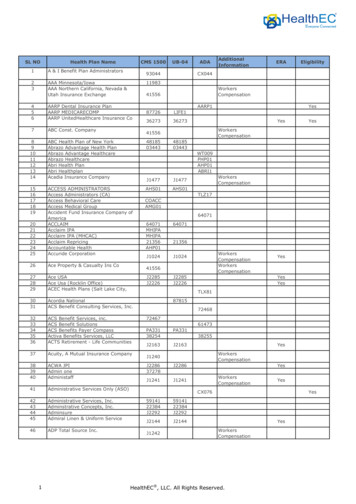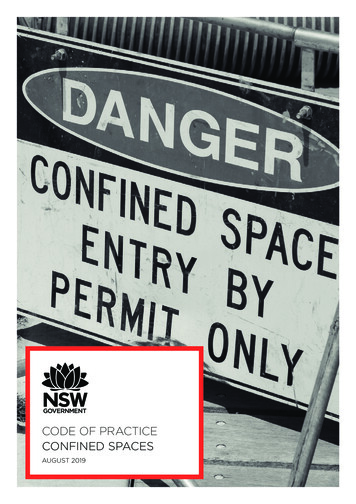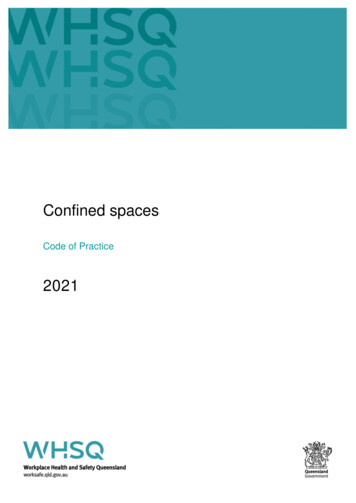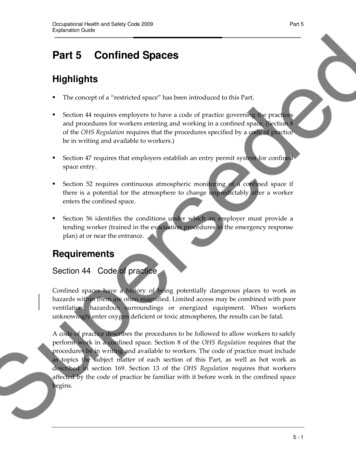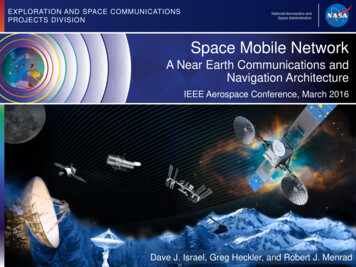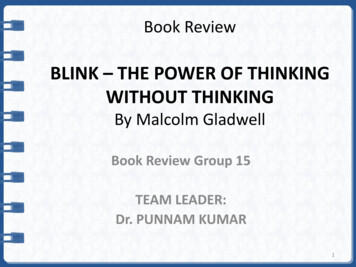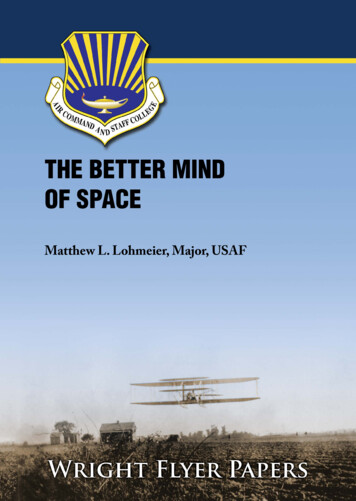
Transcription
THE BETTER MINDOF SPACEMatthew L. Lohmeier, Major, USAF
Air Command and Staff CollegeEvan L. Pettus, Brigadier General, CommandantJames Forsyth, PhD, Dean of Resident ProgramsBart R. Kessler, PhD, Dean of Distance LearningPaul Springer, PhD, Director of ResearchPlease send inquiries or comments toEditorThe Wright Flyer PapersDepartment of Research and Publications (ACSC/DER)Air Command and Staff College225 Chennault Circle, Bldg. 1402Maxwell AFB AL 36112-6426Tel: (334) 953-3558Fax: (334) 953-2269E-mail: acsc.der.researchorgmailbox@us.af.mil
AIR UNIVERSITYAIR COMMAND AND STAFF COLLEGEThe Better Mind of SpaceMatthew L. Lohmeier, Major, USAFWright Flyer Paper No. 79Air University PressMuir S. Fairchild Research Information CenterMaxwell Air Force Base, Alabama
Commandant, Air Command and StaffCollegeBrig Gen Evan L. PettusAccepted by Air University Press October 2019 and published September2020.Director, Air University PressMaj Richard T. HarrisonProject EditorKimberly LeiferIllustratorDaniel ArmstrongPrint SpecialistMegan N. HoehnDisclaimerAir University PressOpinions, conclusions, and recommendations expressed or implied600 Chennault Circle, Building 1405within are solely those of the author and do not necessarily repreMaxwell AFB, AL 36112-6010sent the views of the Department of Defense, the Department k:https://www.facebook.com/AirUnivPressandTwitter: https://twitter.com/aupressAir University Pressthe Air Force, the Air Education and Training Command, the AirUniversity, or any other US government agency. This publication iscleared for public release and unlimited distribution.This Wright Flyer Paper and others in the series are available electronically at the AU Press website: https://www.airuniversity.af.edu/AUPress/Wright- Flyers/
ContentsList of Illustrations ivForeword vAcknowledgments viPreface viiIntroduction 1Mind in the Western Philosophical Tradition 2Part One: Thought About Space 3The Traditional Mind: Thought 3The Emergent Mind: Thought 5Part Two: Purpose in Space 9The Traditional Mind: Purpose 10The Emergent Mind: Purpose 11Part Three: Knowledge of Space 15Facts of Physics 15Facts of Activity 17Two Minds Juxtaposed 18Summary 20Conclusion: The Better Mind of Space 21Abbreviations 30Bibliography 31iii
List of IllustrationsFigure1. Four Regions of Space 72. Earth- moon Lagrange points 18Table1. Summary of the two minds of space iv20
ForewordIt is my great pleasure to present another issue of The Wright Flyer Papers.Through this series, Air Command and Staff College presents a sampling ofexemplary research produced by our resident and distance- learning students. This series has long showcased the kind of visionary thinking thatdrove the aspirations and activities of the earliest aviation pioneers. Thisyear’s selection of essays admirably extends that tradition. As the series titleindicates, these papers aim to present cutting- edge, actionable knowledge— research that addresses some of the most complex security and defense challenges facing us today.Recently, The Wright Flyer Papers transitioned to an exclusively electronicpublication format. It is our hope that our migration from print editions to anelectronic- only format will foster even greater intellectual debate among Airmen and fellow members of the profession of arms as the series reaches agrowing global audience. By publishing these papers via the Air UniversityPress website, ACSC hopes not only to reach more readers, but also to support Air Force–wide efforts to conserve resources. In this spirit, we invite youto peruse past and current issues of The Wright Flyer Papers at https://www.airuniversity.af.edu/AUPress/Wright- Flyers/.Thank you for supporting The Wright Flyer Papers and our efforts to disseminate outstanding ACSC student research for the benefit of our Air Forceand war fighters everywhere. We trust that what follows will stimulate thinking, invite debate, and further encourage today’s air, space, and cyber warfighters in their continuing search for innovative and improved ways to defend our nation and way of life.EVAN L. PETTUSBrigadier General, USAFCommandantv
AcknowledgmentsFirst, I must say thank you to my classmates in the Schriever Scholars Program. Your combined experience and insight have been incredibly valuable tome this year at school. But what will remain more important to me than yourprofessional expertise is that you have become my friends. I look forward toserving with you and coming back to you for counsel and advice.I, of course, would be remiss if I did not also acknowledge and thank thefaculty of the Schriever Scholars program. You have challenged my thinking,opened my eyes to many important issues in national security space, and introduced me to some of the most influential men and women in the community. Thank you for introducing me to the Better Mind of Space.Last, and most importantly, I owe a debt of gratitude to my family. I can noother answer make, but thanks, and thanks, and ever thanks.vi
PrefaceCulture, at a fundamental level, is comprised of shared values and assumptions about reality. It has to do with what is in the mind. Perhaps it is easier toanalyze existing culture than it is to figure out how to change it. Yet that is theproblem I would like to address in this paper. Specifically, how do you improve military space culture?Admittedly, the question is ambiguous, but it is one I have been askedmany times. Implicit in the question is the assumption that military spaceculture needs improvement. I do not challenge that assumption here, ratherI accept it as something deserving of our time and effort. Of course, there area myriad of ways to address any topic, but the idea of culture seems to beamong the more elusive and subjective topics of research pertaining to spaceand space power. What follows is one more meager attempt to transform theelusive and subjective into something within reach.vii
IntroductionIt is necessary to call into council the views of our predecessors inorder that we may profit by whatever is sound in their views andavoid their errors.—AristotleConsider two minds of space. These minds are emblematic of two competing cultures. They are not equal in merit, nor equally prevalent. One is rarewhile the other is common. One is more capable of advancing space powerand the other less capable. After considering the merits and limitations ofeach, the psychological dilemma encountered should prompt those who possess the common mind to abandon it in favor of the rarer mind.1My intent is to compare these two minds of space. The picture that emergesshould help space professionals understand the complex tapestry in whichpolarized disagreements about a number of space- related issues is rooted.2Since its creation, the Air Force has maintained what we will call the traditional mind of space and is responsible for current military space culture. Likethe waning moon, the traditional mind of space is diminishing in vigor,power, and influence. There is a better mind of space emerging that is muchlarger than the Air Force. The emergent mind of space is like the waxingmoon—its illuminated area is increasing, and the clarity and power of its influence is growing.This paper is presented using a framework consisting of three related partsthat correlate to three facts of meaning common to mind agreed upon inWestern philosophy.3 These three facts of meaning are thought, purpose, andknowledge.4 Part one analyzes how we think about space as a fact of mind andwill juxtapose the traditional and emergent minds of space. Parts two andthree similarly analyze our purpose in and our knowledge of space respectively to draw contrasts between the two minds.There is a way to measure improvement to military space culture, but itrequires the kind of intellectual scrutiny of one’s own biases that causes discomfort for the undetermined mind.5 A better understanding of militaryspace culture requires a richer vocabulary than our overused airmindednessand its parallel, and equally uninteresting, spacemindedness. Thinking stopswhen we encounter words familiar to us.6 The utility in presenting this newthree- part philosophical framework lies in the hope that it furthers dialogabout military space culture and leads to better understanding of what spaceis and the role of the military in that realm.1
Mind in the Western Philosophical TraditionThe first fact of meaning common to Western philosophical tradition isthought. Thought serves organizational culture as the mechanism of reasonthat sifts through available data to help determine what is relevant. Thought isshaped by experience, and differences in experience frame differences inthought.7 Thought manifested by the traditional mind of space is differentthan thought manifested by the emergent mind. Different data assume greateror lesser degrees of relevance because the way each of these minds think aboutthe space domain are fundamentally different.The second fact of meaning is purpose or intention. It is the direction ofconduct to future ends. Purpose is the part of the mind that plans a course ofaction with foreknowledge of its goal and is manifested as working in someway toward a desired and foreseen objective. Purposiveness is sometimescalled the faculty of will and can be regarded as the very essence of mentality,or mindset.8 In military parlance, purposiveness equates to vision or mission.9For an organization to be effective, its purpose of mind must be unified andmeaningful. The traditional and emergent minds of space, however, believe indifferent purposes for space. The mutual divergence of thought about, andpurpose in space provides a biased lens through which each mind assessesand weighs the importance of data about space.10The third fact of meaning common to mind is knowledge or knowing.Knowledge is a critical aspect of mind because its utility rests in truth and reality. These realities manifest themselves in the space domain as both facts ofphysics and facts of activity. Therefore, knowledge represents the nexus of thetraditional and emergent minds, and the point from which they develop in different directions and project themselves into opposing spheres of influence.11 Aseparate discussion of each of these three facts of meaning common to mindhelps us to understand a holistic picture of the traditional and emergent mindsof space. The military space professional is then confronted with a decisionabout the relevance and comparative advantage of each of these minds.While the mind is not a distinctly human possession, the concept can alsobe attributed to entire organizations by virtue of its members sharing thesame goals and working toward the same missions.12 The Air Force has itsown mind, and smaller organizations within the Air Force such as Air Combat Command, or for our purposes, Air Force Space Command (AFSPC),have their own minds. The analysis of the traditional and emergent minds ofspace presented here reveals differences that could rightly be referred to ascultural distinctions.13 I assert that changes or shifts in the organizational2
culture are necessarily characterized by the changes or shifts in the mindset ofthe persons who compose the greater organizational whole.14Just as psychologist Dr. Daniel Kahneman’s now famous “System 1” and“System 2” of the brain are notional, so are the two opposing minds of space,and there are people who can identify with either.15 The comparison of thesetwo minds is not intended to imply there are necessarily only two, but servesas a model. These minds may appropriately be viewed as forming two ends ofa spectrum. In time, a different or better mind of space may emerge againstwhich any prevailing mind might be juxtaposed for the purpose of analysis.This comparison serves its purpose by allowing us to clearly examine andquestion the views of predecessors.Part One: Thought About SpaceAirmen think spatially, from the surface to geosynchronous orbit.—Air Force Basic DoctrineOperating in a seamless medium, there are no natural boundaries toconstrain air, space, and cyberspace operations.—The Foundations of AirpowerAir Force Basic DoctrineIn order to analyze thought about space as a fact of mind, we must juxtaposethe traditional mind of space with an emergent one. The traditional mindthinks the air and space domains are an indivisible continuum. It tends to viewmilitary space operations as occurring in one or more of several orbits out to,and including, geosynchronous Earth orbit (GEO), but not beyond. Analysisof the traditional mind requires us to consider how military space professionals came to this belief, and so we turn to airmindedness.16 Understanding howairmindedness translates to space provides a context for the way the traditionalmind forms ideas about space, and from which it reasons about the purposesof space. That mind will then be contrasted with an emergent mind that thinksabout a military space operating area composed of all cislunar17 space and beyond, and that comprehends an expansive astropolitical model.The Traditional Mind: ThoughtThe traditional mind of space thinks about space from the ground up, extending out to GEO. Earth is the only vantage humanity has ever known, and3
this mind has been conditioned to think about space as an inseparable continuation of the air domain.Dr. M.V. “Coyote” Smith noted the first documented use of the term airmindedness occurred in a London Times article published on 26 February1927. At that time, its definition was limited and meant interest or enthusiasm“for the use and development of aircraft.” By the mid-1930s, US Army Airmen such as Henry “Hap” Arnold, Carl “Tooey” Spaatz, and Jimmy Doolittlecultivated an aviation environment that would naturally enlarge the meaningof airmindedness. As Dr. Smith explained, “[airmindedness] included notonly the aircraft and the Airmen who flew them, but the entire community ofscientists, engineers, politicians, lawyers, regulators, manufacturers, and educators . . . who helped build even the tiniest elements of aviation.” The growingunderstanding of what was meant by airmindedness was a necessary precursor to the establishment of an independent Air Force which, they argued, wasable to offer a unique contribution to national security. 18The definition of airmindedness did not stop evolving. In September 1945,Gen Henry H. Arnold, then Commander of the US Army Air Forces, expanded the definition further. Airmindedness was no longer just about military, civil, and private aircraft and aviation, but about airpower. He wanted allAmericans to be airminded and to understand the relevance of airpower. Thischange in focus, though seemingly subtle, was important. The new focus was“not only on using and developing aircraft, but on what else could be developed to enable airpower to reach its full potential.”19As the Cold War ensued, the space race emerged. In addition to the creation of new aircraft, the United States developed capabilities that enhancedairpower’s potential. New developments in atomic weapons and intercontinental missile delivery systems enhanced and supported the Air Force’smanned bomber force. Satellites, too, became operational and began the earliest space- based intelligence gathering missions. These efforts did not justenhance the effectiveness of airpower, though they did that quite well. By integrating these developments into the narrative of airpower, the Air Forcedemonstrated just how vital airpower was to the joint fight. Space was thusused to enhance airpower and airpower’s narrative.20 At the end of the ColdWar, Operation Desert Storm gave the United States a historic opportunity todemonstrate how lethal airpower had become as a result of space- basedenhancement. Around- the- clock sorties that delivered precision munitionswere proof of the supremacy of American airpower.21Demonstrations of airpower, however, were not the only reason space became an indispensable piece of the Air Force narrative. Ownership of spacewas also debated on the political front during the Cold War, and senior Air4
Force leaders helped further that narrative as well. In 1958, Air Force Chief ofStaff, Gen Thomas D. White argued that space was a natural extension of theair domain. He did so in an attempt to secure the rights of ownership forspace capabilities from the other military services.22 Though the other services rejected this bureaucratic grab by the Air Force, as well as the idea thatair and space were a continuum called “aerospace,” the narrative stuck. Eventually, Air Force doctrine defined aerospace as “pertaining to the total expansebeyond the Earth’s surface.”23Since then, the term aerospace has gone in and out of vogue among AirForce senior leaders.24 While not every leader has insisted on the indivisibilityof the air and space domains, the spirit of that idea has lingered. As late asSeptember 2018, amid arguments over the organizational future of nationalsecurity space, the Air Force Association (AFA) strongly opposed the creationof a separate space force on the grounds that not only were air and space indivisible, but the “effects from air and space have been integrated and are indivisible.” Stating that a separate space force would do more harm than good,the AFA proposed the US Air Force be renamed the “US Aerospace Force”and continue its longstanding stewardship of both the air and space domains.To strengthen its argument, the AFA cited General White’s ideas about aerospace from 1958.25The annexation of space to enrich the narrative of airpower resulted in anexpanding definition of airmindedness and the continued cycle of thoughtthat insists air and space are an inseparable continuum. Those who have embraced and defended this narrative of indivisibility appear to be bound toview space from an Earth- centric, ground- to- GEO perspective. While theremay be a growing number of military space professionals who reject the assertions of the AFA, the prevalence of this viewpoint constitutes the way thetraditional mind of space thinks about the domain.The Emergent Mind: ThoughtThe emergent mind of space thinks about the domain not only from theground up and out to GEO, but beyond GEO as well. Retired Air Force BrigGen S. Peter Worden aptly captured the way the emergent mind thinksabout space:The Air Force needs to focus on true “strategic” objectives in space. These are objectivesfor the coming Century. . . . True space operations will spread across the solar systemin the decades ahead and the nation that controls them will dominate the planet.Focusing on low Earth orbit (LEO) is akin to having a Navy that never leaves sight ofthe shore. The US military needs to focus on “blue- water” space operations—GEO andabove. US military space operations need to be in deep space, initially all of cislunar5
space, with an eye upon the entire inner solar system. To operate in deep space oneneeds to use the resources there, starting with fuel from asteroids. Once this is recognized, the military- economic imperative of identifying and protecting these assets becomes clear. The focus . . . should be to be sure on low- cost access to real outer space—with “space” beginning at GEO. New means of moving around in space are moreimportant than just getting off the ground.26While Brigadier General Worden touched upon both thought about andpurpose in space, the focus is on his remarks as they pertain to thought aboutthe domain. He explained the irrationality of a perpetual near- Earth focusthrough a Naval analogy, and argued that US military space operations shouldbe focused on deep space beyond GEO.Brigadier General Worden is not alone in asserting that thought about thespace domain must not be limited to our near- Earth orbits. In his classic anddebated work, Astropolitik, Dr. Everett Dolman suggested a model that comprehends space beyond GEO. It is a view from the distinct vantage of spacewhere Earth exists in one of four interconnected regions relevant to militaryspace professionals. In his work, he posited the resurrection of geopoliticswith an application in the space domain may be a useful goal, but that it wouldrequire “at a minimum continuing political relevance.” That political relevance comes, in part, from understanding that we live in an era of the re- emergence of great powers, and that we are transitioning from a world inwhich the United States is the sole superpower to a multipolar world. As classical geopolitical theory has tended to amplify the centrality of national andregional rivalries, our world of multipolar peer competition should considerwhat Dr. Dolman termed the astropolitical space landscape.27Just as the interactions of distinct regions and domains on Earth have defined the course of global history, it is likely that future interactions withincertain regions of space will have bearing upon the destiny of humankind.28There are four regions of space that are of interest to military space professionals described in Dr. Dolman’s model. They are:1. Terra or Earth, including the atmosphere stretching from the surface tojust below the lowest altitude capable of supporting unpowered orbit. . . .[The inclusion of a terrestrial region is a critical concept for Dolman’smodel, and is a proper setting for space activities.] It is on the surface ofthe Earth (Terra) that all current space launches, command and control,tracking, data downlink, research and development . . . and storage operations are performed. Terra is the only region or model that is concerned with traditional topography in the classic geopolitical sense, andis the transition region between geopolitics and astropolitics.6
2. Terran or Earth Space, from the lowest viable orbit to just beyond geostationary altitude (about 36,000 km). Earth space is the operating medium for the military’s most advanced reconnaissance and navigationsatellites, and all current and planned space- based weaponry. At itslower limit, Earth space is the region of post- thrust medium– and long–range ballistic missile flight, also called [LEO]. At its opposite end,Earth space includes the tremendously valuable geostationary belt,populated mostly by communications and weather satellites.Moon(Luna)Earth orTerran spaceTerraLunar orbitMoon orLunar spaceSolar spaceGeosynchronous orbit(not to scale)Figure 1. Four Regions of Space.293. Lunar or Moon Space is the region just beyond [GEO] to just beyondlunar orbit. The Earth’s moon is the only visible physical feature evidentin the region, but it is only one of several strategic positions locatedthere. Earth and lunar space encompass the four types of orbits [used bythe preponderance of artificial satellites], with the exception of thehighly elliptical orbit with apogees beyond the orbit of the moon, currently used exclusively for scientific missions.4. Solar Space consists of everything in the solar system (that is, within thegravity well of the Sun) beyond the orbit of the Moon. . . . the exploration of solar space is the next major goal for manned missions andeventual permanent human colonization.30 The near planets (Mars andVenus), the Jovian and Saturnian moons, and the many large asteroidsin the asteroid belt undoubtedly contain the raw materials sufficient toignite a neo- industrial age. From an antiquated geopolitik point of view,it also contains the lebensraum for a burgeoning population on Earth.31The traditional mind of space has focused only on the first two regions ofDr. Dolman’s astropolitical model. However, if Brigadier General Worden’s7
view of space is correct then we have merely been parked near Earth’s proverbial shores. The emergent mind believes all four regions of space have importance, but that Dr. Dolman’s third region specifically has great significance tothe military space professional. His lunar space, or what is commonly calledcislunar space, is home to many strategic positions. Those strategic positionsinclude, but are not necessarily limited to:1. the lunar surface, especially the water- ice covered poles,322. lunar peaks of 24-hour continuous solar exposure,3. lunar orbit, from which deep space maneuver is greatly enabled,334. Earth- moon Lagrange points outside of the gravity wells of the earthand moon,34 and5. near- Earth asteroids, which are rich in platinum group metals.35Those strategic positions might be termed key terrain, since their exploitation affords a marked advantage to the state that successfully stages there.36 Inaddition to strategic security advantages, these staging points also have thepotential to enable a cislunar economy. There are an increasing number ofprivate and commercial space companies that have plans to expand into cislunar space, exploiting its resources to meet Earth’s growing energy demands,boosting US economic strength, and propelling space industrialization in away that is not possible by utilizing Earth’s resources alone.37Proponents of US space power who think about space in this manner arenot the only strategists who think about the space operating environmentbeyond GEO. It appears the emergent mind of space is shared by China,which also has strategists who view the moon and other fourth region solarspace planets as strategically significant. The head of China’s lunar exploration program, Ye Peijian, said, “The universe is an ocean, the Moon is theDiaoyu (Senkaku) Islands, Mars is Huangyan Island (Scarborough Shoal).”38This public position is evidence that America’s leading space competitorthinks about space differently than Western military space professionals havetraditionally perceived the domain.The traditional mind therefore has an indivisible aerospace continuum, andthe emergent mind has its four regions. To the former, its eyes are fixed uponorbits out to GEO, and what lies beyond GEO is the realm of the NationalAeronautics and Space Administration (NASA) and the scientist. To the latter,space can be modeled as an astropolitical environment in which there are different regions that are each important to the military space professional—regions that may define the future of humanity. Rejecting the idea that geo8
graphic, topographic, and positional nuance is a matter of mere analogy, butrealities to which the principles of classical geopolitics may be applied for advantage, the emergent mind of space is capable of strategizing and planning inthe domain in ways the traditional mind of space does not and cannot.39Part Two: Purpose in SpaceWe must assume future war on Earth will extend into Space. We willneed to ‘fight through’ attacks on our space assets and capabilities andcontinue to provide the space support our warfighters need and havecome to expect.—Deputy Secretary of Defense Robert O. WorkThe fact of meaning common called purpose is the why, or to what end ofspace and space power. In military parlance, purpose, or intention, is captured in an organization’s mission and vision, and so we shall survey the current mission and vision of Air Force military space professionals. Vision isaspirational, and “refers to a picture of the future with some implicit or explicit commentary on why people should strive to create that future.” It clarifies the general direction for change and transformation, motivates people totake action in that direction, and creates a unity of effort in a remarkably fastand efficient way. Mission is also related to purpose because, notionally, itexplains who is involved in what, when, and where, as well as why. Purpose istherefore important because it is simultaneously aspirational and practical. 40The traditional and emergent minds have distinct purposes in space. Thetraditional mind emphasizes support but does not necessarily think dominance is an unworthy aim. The emergent mind, on the other hand, emphasizes its purpose to dominate, but understands space will always enable andenhance the joint fight. The former articulates the importance of space powerby an appeal to airpower’s narrative. The latter characterizes space power’simportance as an increasingly independent narrative.These contrasting purposes have recently been on display in the argumentsfor and against an independent space force. Those with the traditional mindof space tend to be critics of independence for space. They believe space forcesas components of airpower provide adequate support for joint warfighters,and that independence might damage joint integration. The emergent mindtends to advocate for an independent space force, believing space dominanceis more likely to be achieved, and America’s role as leaders in space more cer9
tain to be secured, if dominance of the domain is sought by a military servicewhose sole responsibility is just that.The Traditional Mind: PurposeShortly after President Trump directed the stand up of an independentspace force in 2018, many in the defense establishment began reiterating theirreasons why it was a bad idea. Among the most common arguments: the newspace force would be too expensive, it would create too much bureaucracy, itwould hurt joint integration, and the timing was not yet right.41 One journalisteven suggested that a new military service for space would make the UnitedStates weaker.42 Retired Air Force Lt Gen David Deptula argued that while aspace force was the right decision, the timing was off, and that vital prerequisite conditions had to be met before creation of an independent force.43 Thoughhe acknowledged some of the conditions were met, he believed the UnitedStates should not yet establish the space force as an independent service because the US has thus far been unable to develop a general space power theory,and has not developed the capability to produce direct combat power in orfrom space as a “co- equal contributor” to joint multi- domain operations.44He claimed these conditions were vital to the success of the future spac
Sep 28, 2020 · the waning moon, the traditional mind of space is diminishing in vigor, power, and influence. There is a better mind of space emerging that is much larger than the Air Force. The emergent mind of space is like the waxing moon—its illuminated area is increasing


